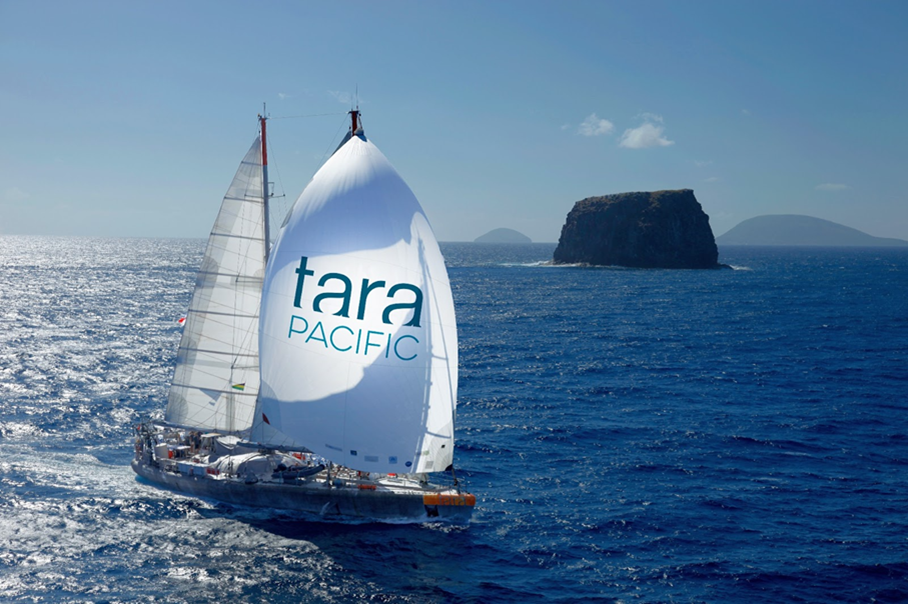There's way more tiny life on Earth than scientists had thought, study of coral reefs finds
With coral reefs in decline around the globe, scientists weren’t sure what they’d find during a 2?-year research cruise to survey the very tiniest organisms living among the fish and corals of Pacific Ocean reefs.
After thousands of samples and many hours of genetic research, they were stunned by the rich biodiversity they found.
“What amazed us is the huge diversity of microbes that we counted across the Pacific reefs,” said Pierre Galand, a co-author of the study and microbial ecologist at Banyuls Oceanological Observatory in France.
Nearly as many microscopic organisms may live among coral reefs as all the microbes previously identified around the globe, Galand and other scientists collaborating on the Tara Pacific Expedition said this week. And their work, published Thursday in a series of eight journal articles and papers, including four in Nature Communications, isn't finished yet.
Coral reefs are important, even though they account for only 0.2 % of the surface of the world’s oceans, because 1 of every 3 species in the oceans live among the reefs, said Serge Planes, director of the Island Research Center and Environmental Observatory in France.
Reefs support millions of organisms and associated microorganisms, Planes said, yet the extent of that biodiversity has not been fully explored.

Cruising for coral
With coral reefs diminishing as a result of human activities and climate change, the researchers said, understanding microorganisms and the role they play in keeping coral reefs healthy is essential for restoration and protection.
The vast majority of the world’s coral reefs are in the Pacific Ocean. The greatest coral diversity in the Pacific is within waters known as the "Coral Triangle, between Indonesia, Malaysia, Papua New Guinea and the Philippines," Planes said.
About 12% of the world's coral reefs lie within the Indian Ocean, and the Caribbean contains about 7%, he said. Reefs in other isolated locations, such as the Red Sea, Persian Gulf and Mozambique Canal, also are likely to have unique microfauna and microbiofauna.
Aboard the Tara, they sampled fire coral, lobe coral and cauliflower coral and the fish species convict tang and Moorish idol, with their associated plankton and bacteria.

Tara Pacific research cruise by the numbers
29 months, from May 2016 to October 2018.
32 islands.
99 coral reefs.
70 scientists from 23 institutions and laboratories in eight countries.
100,000 kilometers sailed (more than 62,000 miles).
What the research expedition collected
58,000 samples.
12,190 photos.
Genetic data equivalent to 50,000 human genomes.
2.87 billion genetic sequences of microorganisms of fish, coral and plankton.
542,399 different bacteria.
The biggest challenge
From the beginning, it was important for the expedition to sample everything using the same equipment, tools and protocols to ensure the integrity of the data for years to come so it could be used and shared among scientists.
"When I will be retiring or people won't be available, those data will still be usable for the community, so that's the legacy of the cruise," said Fabien Lombard, a co-author with Sorbonne University in Paris. Even when other scientists were aboard, they wanted to have everything fully comparable, keeping track of each process, so it could be repeated.
'Huge' biodiversity found among Pacific corals
Once the researchers started looking at their samples with powerful computers, they found more new microbes with each new sample, Planes said.
When they extrapolated the diversity they found to the hundreds of other species of fish and corals found across the Pacific reefs, “the number of microorganisms, including bacteria, equal the total estimated diversity on the entire Earth. So huge, huge numbers,” he said. "The microbial biodiversity in this ecosystem is really enormous."
They were expecting the diversity would reach a kind of plateau, “but we still haven’t reached a plateau," he said. Their data leads them to conclude it's likely the total biodiversity of microbes on Earth has been underestimated.
Coral reefs in crisis
Scientists collaborating on the Tara expedition hoped to understand how the relationship between corals and bacteria helps productivity on the reefs. In one case, they found three new species of bacteria closely associated with a coral species, producing vitamins and amino acids important for the coral.
They also looked at changes in water temperature.
One potential angle of climate research that has been largely overlooked is how warming makes wildlife and humans age faster, said Eric Gilson, with the Universite Cote d'Azur in France. The Tara project results, which suggest the response of coral telomere to environmental change determines its aging trajectory, emphasize the importance of studying the effects of warming on aging in wild populations, said Gilson, a corresponding author on a paper about the coral's response to temperature changes.
The large diversity they found in the tiniest organisms in some ways reassured the scientists, Planes said. If a species that fulfills a crucial role in the reef is in trouble because of pressures from humans, another may be able to take its place.
“It’s insurance, basically, for the survival of the function of the reef," Planes said. "At a time when coral reefs are in a crisis, this is the place where you have a reservoir in some ways, the place where you have a really huge reservoir of biodiversity."
Coral reef facts
According to the World Resources Institute:
Reefs provide food and livelihoods, reduce storm surge and flood risk to coastlines across the tropics, protect against erosion, and attract tourists in more than 100 countries and territories.
50% of the planet's coral reefs are endangered.
25% appear to be in good health.
20% to 25% have been destroyed.
This article originally appeared on USA TODAY: Scientists amazed by biodiversity of tiny life found on coral reefs
Solve the daily Crossword

